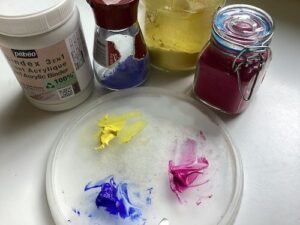Pebeo 3in1 acrylic binder - review
I’ve talked about it before and this week I was finally able to test it properly: the acrylic binder 3in1. The name may be a bit redundant, because this acrylic binder does exactly what all other acrylic binders are used for: as a base/gesso, as a binder for pigments (paint) and as a finish/varnish/sealing/glue.


It consists of recycled acrylic, both the product and the packaging, and complies with the strict German Blauer Engel certification. This eco-label was created by the German government in 1978 to protect the environment better.
I have used this binder as a glue in collage techniques and for making acrylic paint where I either used pigment powder or a little gouache and watercolour paint. When making the paint, it appears that the color becomes lighter. So I take into account the fact that as the paint dries it will darken.

For this test, I took two pieces of 30x30cm linen cardboard, one of which I made completely wet. In diluted form, i.e. without the marble dust and with some water, the paint remains smooth. With the wet-in-wet technique, which is mainly known among water colourists, I can create beautiful, dreamy transitions because it blends well on paper, but there is no mutual struggle between the colours to take up their place.

For the next layer, I mix marble dust into the paint and apply it with a palette knife. The pasty way of working gives a lot of expression on paper. I can spread parts that I want to be a little softer with a slightly damp brush and paint.
Immediately after painting I took a photo (on the left side in the photo right), the paint was still wet. The next day I took another photo(on the right side). To my surprise, the paint actually dried a bit lighter and the wet-in-wet technique continued to simmer, so that the background is even more dreamy.
The photo’s show a part that was only painted with the watery version of the paint, so not mixed with the marble dust.

I think the Pebeo 3in1 acrylic binder is a nice alternative to the common acrylic binders, but I can imagine that the seasoned acrylic binder user will have to get used to the diluted form.
And let’s not forget that, although the CO2 emissions of this product are 6 to 7 times less than an average acrylic binder, it still consists of acrylic and therefore microplastics.
